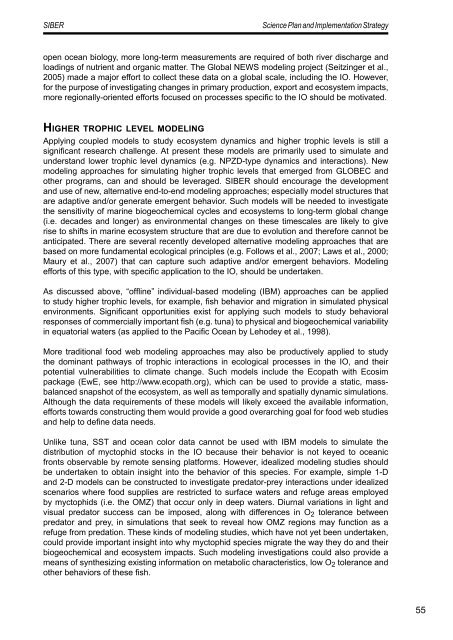SIBER SPIS sept 2011.pdf - IMBER
SIBER SPIS sept 2011.pdf - IMBER
SIBER SPIS sept 2011.pdf - IMBER
Create successful ePaper yourself
Turn your PDF publications into a flip-book with our unique Google optimized e-Paper software.
<strong>SIBER</strong><br />
Science Plan and Implementation Strategy<br />
open ocean biology, more long-term measurements are required of both river discharge and<br />
loadings of nutrient and organic matter. The Global NEWS modeling project (Seitzinger et al.,<br />
2005) made a major effort to collect these data on a global scale, including the IO. However,<br />
for the purpose of investigating changes in primary production, export and ecosystem impacts,<br />
more regionally-oriented efforts focused on processes specific to the IO should be motivated.<br />
Hig h e r tr o p h i c le v e l mo d e l i n g<br />
Applying coupled models to study ecosystem dynamics and higher trophic levels is still a<br />
significant research challenge. At present these models are primarily used to simulate and<br />
understand lower trophic level dynamics (e.g. NPZD-type dynamics and interactions). New<br />
modeling approaches for simulating higher trophic levels that emerged from GLOBEC and<br />
other programs, can and should be leveraged. <strong>SIBER</strong> should encourage the development<br />
and use of new, alternative end-to-end modeling approaches; especially model structures that<br />
are adaptive and/or generate emergent behavior. Such models will be needed to investigate<br />
the sensitivity of marine biogeochemical cycles and ecosystems to long-term global change<br />
(i.e. decades and longer) as environmental changes on these timescales are likely to give<br />
rise to shifts in marine ecosystem structure that are due to evolution and therefore cannot be<br />
anticipated. There are several recently developed alternative modeling approaches that are<br />
based on more fundamental ecological principles (e.g. Follows et al., 2007; Laws et al., 2000;<br />
Maury et al., 2007) that can capture such adaptive and/or emergent behaviors. Modeling<br />
efforts of this type, with specific application to the IO, should be undertaken.<br />
As discussed above, “offline” individual-based modeling (IBM) approaches can be applied<br />
to study higher trophic levels, for example, fish behavior and migration in simulated physical<br />
environments. Significant opportunities exist for applying such models to study behavioral<br />
responses of commercially important fish (e.g. tuna) to physical and biogeochemical variability<br />
in equatorial waters (as applied to the Pacific Ocean by Lehodey et al., 1998).<br />
More traditional food web modeling approaches may also be productively applied to study<br />
the dominant pathways of trophic interactions in ecological processes in the IO, and their<br />
potential vulnerabilities to climate change. Such models include the Ecopath with Ecosim<br />
package (EwE, see http://www.ecopath.org), which can be used to provide a static, massbalanced<br />
snapshot of the ecosystem, as well as temporally and spatially dynamic simulations.<br />
Although the data requirements of these models will likely exceed the available information,<br />
efforts towards constructing them would provide a good overarching goal for food web studies<br />
and help to define data needs.<br />
Unlike tuna, SST and ocean color data cannot be used with IBM models to simulate the<br />
distribution of myctophid stocks in the IO because their behavior is not keyed to oceanic<br />
fronts observable by remote sensing platforms. However, idealized modeling studies should<br />
be undertaken to obtain insight into the behavior of this species. For example, simple 1-D<br />
and 2-D models can be constructed to investigate predator-prey interactions under idealized<br />
scenarios where food supplies are restricted to surface waters and refuge areas employed<br />
by myctophids (i.e. the OMZ) that occur only in deep waters. Diurnal variations in light and<br />
visual predator success can be imposed, along with differences in O 2 tolerance between<br />
predator and prey, in simulations that seek to reveal how OMZ regions may function as a<br />
refuge from predation. These kinds of modeling studies, which have not yet been undertaken,<br />
could provide important insight into why myctophid species migrate the way they do and their<br />
biogeochemical and ecosystem impacts. Such modeling investigations could also provide a<br />
means of synthesizing existing information on metabolic characteristics, low O 2 tolerance and<br />
other behaviors of these fish.<br />
55












